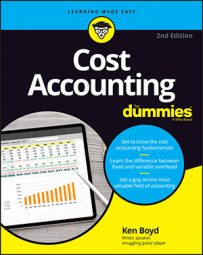In cost accounting, the matching principle matches revenue with the expenses related to it. You tie the revenue from selling a unit to the cost of making a unit. This concept is also used to allocate joint costs.
You can allocate joint costs based on the revenue the units generate. Accountants refer to this as the market-based approach. Market refers to the market value (sales value) of the product. The market-based method you see here is the sales value at splitoff method. You also see the physical measures method of allocating joint costs.
The sales value at splitoff method of cost accounting
One method of allocating joint costs is to allocate costs based on the benefits received from the expense. Revenue is a benefit received from incurring joint costs. That’s the basis for using a market-based approach.
Say you own a lumber company and mill. Your crews cut down trees and produces two types of lumber for the construction industry. Both types are two-by-fours (two inches by four inches by eight feet in length). Winter Pine is the more expensive product; the all-year-use two-by-fours are cheaper. The following table explains how to allocate $208,000 in joint costs using the relative sales value method.
| Winter Pine | All-Year-Use | Total | |
|---|---|---|---|
| Production | 10,000 | 16,000 | 26,000 |
| Unit price | $12 | $8 | |
| Relative sales value | $120,000 | $128,000 | $248,000 |
| Percent sales value | 48.39 | 51.61 | 100 |
| Cost allocated | $100,645 | $107,355 | $208,000 |
| Cost per unit | $10.06 | $6.71 |
A product’s relative sales value is unit price x production. The total sales value for both products is $248,000, and about 48 percent of the sales value is for Winter Pine. The joint cost allocation for Winter Pine is $100,645 (48.39 percent, or 0.4839 x $208,000). To check your work, add the two joint cost allocations and verify that they sum up to $208,000. Here’s the cost per unit for Winter Pine:
Cost per unit, Winter Pine = cost allocation ÷ units produced
Cost per unit, Winter Pine = $100,645 ÷ 10,000
Cost per unit, Winter Pine = $10.06
The physical measure method of cost accounting
The physical measure method allocates cost by the weight, volume, or some other measurement of the product that’s produced. It’s a contrast to relative sales value. In this case, assume that the weight or volume for each two-by-four is the same. (Well, yeah. They are both two-by-fours.) So you allocate joint costs based on the number of units produced. Check out the following table.
| Winter Pine | All-Year Use | Total | |
|---|---|---|---|
| Production | 10,000 | 16,000 | 26,000 |
| Percent production | 38.46 | 61.54 | 100 |
| Cost allocated | $80,000 | $128,000 | $208,000 |
| Cost per unit | $8 | $8 |
Winter Pine’s 10,000 units of production are 38.46 percent of the total. The cost allocated is $80,000 (38.46 percent or 0.3846 x $208,000). The all-year-use product gets the rest, $128,000. The total cost allocated sums up to $208,000. The new version of cost per unit for Winter Pine is
Cost per unit, Winter Pine = cost allocation ÷ units produced
Cost per unit, Winter Pine = $80,000 ÷ 10,000
Cost per unit, Winter Pine = $8
In the table, the cost per unit is the same for both products. That’s because the joint cost allocation isn’t related to cost because it uses the physical measure method. Because you’re allocating based on number of units, the cost attached to all units is the same. You’re not weighting the cost allocation based on sales value.

